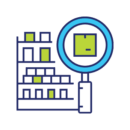Warehouse Management System
The Warehouse Management System is part of the LaceUp product suite developed for Distributors, Manufacturers, and Warehousing companies. This WMS optimizes the supply chain process by eliminating errors, maximizing warehouse efficiency, and providing full end-to-end inventory traceability. It uses a mobile warehouse app on a scanner. Here is what you can expect from the warehouse management system.
-
Know the Whereabouts of Every Product, Lot Number & Expiration Date
-
Manage Infinite Inventory Locations
-
Integration with Heavy Duty Mobile Scanners
-
Eliminate Manual Processing of All Warehouse Transactions
-
Reduce Man-Hours by Optimizing All Warehouse Resources
-
Straightforward Implementation
-
Integration With QuickBooks and Many Other ERP Systems

Receiving Purchase Orders
This feature minimizes the errors in the receiving process by tracking mismatches between the purchase order and the actual products received. Products received are scanned against the existing purchase orders within the mobile warehouse app. Once scanned, the system will calculate and/or compute any difference between the PO and the physical product.
Pallet & Case Labeling
Once the product is received, the mobile warehouse app has a print button. When tapped it will create a label that can be adhered to individual cases or the pallet itself. The label can be configured to contain the product information, product lot number, product expiration date, and the product serial number within a QR Code.

Check-In Product
Once you have received and labeled the inventory, the warehouse management system will prompt you to check-in the inventory into a bin location. Using the mobile warehouse app, the system will tell the user exactly what bin locations are available for that inventory. The LaceUp Check-In feature allows you to optimize the placement of products within the warehouse. With it you can check-in products in a way that allow your pickers to run the most efficient route and know exactly the product whereabouts. The beauty of this is that the system will know exactly where you can inventory each item, where it fits, and where it is authorized. This is important to avoid a scenario where your warehouse personnel picks something extremely light like a carton of eggs and places it on top of a heavy case of bottles.
Picking Orders
Picking is the process of preparing a sales order to be delivered to the customer. The picker will be able to view the order in the mobile warehouse app. The picker will see the items on the order, item bin locations, and item availability. Bin locations will be sorted by the most efficient pick sequence. Upon arriving at the bin location, the picker will scan the bin to confirm that the scanned bin contains the correct product. This scan will capture the lot number, expiration date, and flag the product as picked on the order. When you are done picking an order, the system allows you to print a packing slip and/or a pallet label. This label can be adhered to each pallet going. These functionalities will decrease the costs by reducing the time and errors of the picking process.
Cycle Count
Every company knows just how difficult it is to count everything in an entire warehouse. A good warehouse management system makes periodic audits parts of the inventory called Cycle Counts. LaceUp’s warehouse management system will prompt your mobile device to select what item you are going to count. Then it will prompt warehouse personnel to scan the bin location. The warehouse employee can then count all product within the bin location. The system will calculate the difference between what was counted and what is present in the bin. This will generate an inventory adjustment.

Transfer of products
The mobile warehouse app will display when the product within the picking level has reached a low level. The user will see where the products reside in overstock to initiate a transfer. Laceup’s Transfer tells exactly what bin to transfer from and what bin to transfer to, using first in/first out (FIFO). To complete the transfer just scan the label on the bin and the pallet that you are transferring from. Then scan the bin that it is going to.
Route Returns
Route returns are specific to distributors or companies who have delivery trucks where inventory goes onto a truck and partially returns to the warehouse at the end of the day. Some of these returns may have been refused by a customer and are good returns. On the other hand, some returns may have gotten damaged during transportation or expired in the store. With LaceUp’s warehouse app the receiver scans the item, and will ask to classify it in one of three ways. Is the item damaged? Is the item going to be delivered again tomorrow? Or is the item going to return to its picking bin because it’s no longer needed by the customer?
| LaceUp Functionalities | |
| Supplier Purchase Cycle | |
| PO Forecasting Report | |
| PO tracking | |
| Supplier Order Receiving | |
| item labeling generation and scan | |
| Bin labeling generation and scan | |
| Product Check-In | |
| Truck inventory Management | |
| Truck inventory per truck | |
| Transfer capability WH-Truck-WH | |
| Damage products reception | |
| Inventory reconciliation | |
| Route Returns | |
| Bin Location Management | |
| Multiple locations | |
| Multiple Areas | |
| Product location capabilities | |
| Transfer between locations and between overst | |
| Lot Tracking | |
| Optimum Picking Route | |
| Cycle Count | |
| Picking Process | |
| List of pending orders to pick | |
| Different units of measures | |
| Bin location indication | |
| Stock availability | |
| FIFO Management | |
| Picking label printing (staging) | |
| Checker Module | |
| Synch with ERP | |
| Traverse | |
| IntegraSys | |
| QuickBooks Desktop | |
| QuickBooks Online | |
| Sage BusinessWorks | |
| Sage 50 | |
| Sage 100/MAS 90 | |
| Sage 300 | |
| Microsoft Dynamics Great Plains | |
| Microsoft Dynamics Navision | |
| Microsoft Dynamics Dynamics 365 | |
| Microsoft Dynamics Just Food ERP | |
| SAP Business One & B1 HANA | |
| NetSuite | |
| FishBowl Inventory Software | |
| Acctivate Inventory Software | |
| Reporting | |
| Platforms | |
| Android | |
| Windows | |
| Windows Hosted In The Cloud SaaS |

